Net-zero shipping: Key findings from the latest Maritime Forecast
The maritime industry faces a pivotal moment as it adapts to regulation, including the new IMO Net-Zero Framework (pending adoption), aimed at reducing ship greenhouse gas emissions. DNV’s latest Maritime Forecast to 2050 offers practical insights and analysis to help stakeholders make informed decisions on ships, fuels, technologies and infrastructure for a net-zero future.
“For shipowners exploring low-GHG fuels and onboard carbon capture, knowing when and where they can refuel and offload captured CO₂ is crucial,” explains Eirik Ovrum, Maritime Principal Consultant at DNV and lead author of the paper. In this article, we highlight the latest developments and emphasize the importance of Chain of Custody models to verify the origin and sustainability of alternative fuels.

Setting a new course for shipping
Shipping’s energy transition is being shaped by IMO’s revised 2023 GHG Strategy: a 20 per cent emissions reduction from shipping by 2030, a 70 per cent reduction (at least) by 2040, and full-scale decarbonization “by or around” 2050 – all compared with 2008 levels.
The Net-Zero Framework (NZF) aims to accelerate the adoption of low-GHG fuels and technologies. While voting on adoption of the NZF has been delayed to October 2026, Maritime Forecast to 2050 describes the NZF and compares its consequences with those of relevant EU regulations.
The NZF is based on a GHG fuel intensity (GFI) metric expressed in amount of carbon dioxide (CO2), or its equivalent, per unit of energy used on board in a calendar year on a well-to-wake basis.
If adopted, the NZF is anticipated to introduce progressively stricter GFI targets annually, affecting technology choices and the operation of ships, as well as the development of shoreside infrastructure and the availability of low-GHG fuels and CO2 storage.

Tracking the fuel and technology transition
Drawing on data from DNV’s Alternative Fuels Insight platform and S&P Global, Maritime Forecast to 2050 reveals a clear shift: LNG and methanol are gaining traction, while ammonia, hydrogen and on-board carbon capture are entering early trials.
With nearly as many alternative-fuel ships on order as currently in service, the fleet of such vessels is set to almost double between 2024 and 2028, based on the current order book. Assuming all vessels operate at their maximum capacity for alternative fuels, the global fleet’s potential alternative fuel consumption could reach about 50 Mtoe by 2030 (excluding biodiesel), with LNG leading, followed by methanol, LPG, ammonia and hydrogen. Biofuel availability is also expanding in ports, as a map in the paper reveals.
Fuels like bio-methane could emerge prominently as a drop-in fuel for the substantial and growing number of dual-fuel LNG vessels currently in operation and on order. When regulatory pressure to lower GHG emissions intensifies, transitioning these vessels from fossil-LNG to bio-LNG and e-LNG could provide an effective and seamless path to net zero. This is critical to ensure that previous investments in infrastructure development and ships do not get lost.
“As the transition accelerates, better crew training and competence are urgently needed for the safe, secure operation of alternative-fuel ships. Based on the order book, we estimate that around 33,000 additional seafarers need alternative fuel training over the next three to four years,” observes Ovrum.
Wind propulsion is gaining momentum in maritime decarbonization. As of August 2025, 64 ships are equipped with modern wind-assisted systems, with 56 installed since 2020 and 75 per cent as retrofits. Rotor sails dominate bulk carriers and tankers, while suction sails are more common on general cargo vessels. With 84 additional ships in the order book, growth is picking up, driven by GHG regulations. Several pilot and third-party tests are underway for wind-assisted propulsion technologies. If their effectiveness is demonstrated, this could build industry confidence and further accelerate investment and adoption.

Low-GHG fuel availability now and in the future
Shipping must overcome three main barriers in order to achieve the uptake of low-GHG fuels at scale: technology and safety; demand and costs; and fuel availability.
In 2023, global energy demand reached 10,600 Mtoe, with maritime transport accounting for 3 per cent. As competition for low-GHG fuels intensifies, especially from aviation, trucking and industry, Maritime Forecast to 2050 estimates global production capacity by fuel type, offering high and low scenarios based on RED II sustainability criteria. Despite delays, projected capacity for 2030 is 70–100 Mtoe (for all sectors and including biodiesel), up 50 per cent from last year due to the inclusion of bio-methane. Yet only 4 per cent of hydrogen-derived projects have reached a final investment decision, and just 1 per cent are operational. Maritime fuel demand under the NZF is also assessed in the report.
“Meeting IMO and EU targets will need a major scale-up in low-GHG fuel production,” says Øyvind Sekkesæter, Senior Consultant, Environment Advisory at DNV and co-author of the report. “As for fuel infrastructure, biofuel and LNG bunkering are well established in many places, but the bunkering of other alternative fuels is still limited to a few locations.”

Flexible Chain of Custody can support fuel transition
The Maritime Forecast outlines how Chain of Custody models tracing and verifying the sustainability of low-GHG fuel supply can boost availability and reduce investment needs for storage and bunkering infrastructure.
Flexible models such as mass balance and book and claim for full flexibility allow sustainability tracking without physically separating fuel types, cutting energy losses and infrastructure costs.
For LNG and bio-LNG, Maritime Forecast to 2050 argues that applying mass balancing to interconnected infrastructure would allow the use of fossil LNG terminals and natural gas pipelines instead of building separate infrastructure for bio-LNG/bio-methane.
Using a fully flexible book-and-claim Chain of Custody model could save up to 0.55 Mtoe of energy annually if all bio-methane produced in the EU were used as ship fuel, by avoiding energy losses from separate transport and liquefaction infrastructure.
Meanwhile, existing industrial terminals for methanol and ammonia offer a foundation for maritime distribution, easing last-mile delivery challenges. Robust governance and systems like the EU’s Union Database for Biofuels ensure transparency and compliance, further supporting market growth and investment in renewable fuel production.
“Greater use of more flexible Chain of Custody models could strengthen markets for bio-LNG, incentivizing more production of a fuel offering an increasingly clear decarbonization pathway as the number of LNG-fuelled ships grows,” explains Sekkesæter.

Scaling up CO2 infrastructure: Matching the impact of low-GHG fuels
Maritime Forecast models that equipping 20 major ports with CO2 offloading infrastructure and retrofitting enough ships with on-board carbon capture and storage (OCCS) technology could be as effective as using 25 Mtoe of low-GHG fuels per year in reaching IMO’s 2030 base target. This estimate is contingent on OCCS being incorporated into IMO regulations and the IMO Life Cycle Assessment guidelines – a process initiated by the approval of a regulatory development work plan for OCCS at MEPC 83 in April 2025.
Building on last year’s paper, DNV’s latest analysis of global CO2 storage projects (excluding enhanced oil recovery) points to a 25 per cent increase in projected storage capacity by 2030 to reach 49–85 MtCO2 per year.
Recent positive developments include Northern Lights starting operation as the first cross-border and open-access central site to which European industries can ship CO2 for permanent storage. The project is also to increase its storage injection capacity.
“It’s important to distinguish between total capacity and available capacity,” advises Ovrum. “Capacity is typically reserved in advance and carbon capture projects and storage infrastructure are often developed in parallel. It can be difficult for the maritime sector to secure reliable, long-term agreements for CO₂ storage from many different ships, compared to the simpler process of arranging storage for just a few large industrial emitters.”
Without secured access to storage sites, shipowners and operators risk having limited access to permanent storage for the CO2 captured. This risk, Maritime Forecast to 2050 notes, can lead to the first on-board carbon capture projects aiming for the utilization of CO2 rather than permanent storage.
Given the circumstances, while DNV’s 2030 CO2 storage forecast is higher than a year ago, maritime players should engage early with storage or utilization project developers, advises Ovrum.

Navigating compliance: Case-by-case strategies for shipowners
“As regulations reshape the maritime landscape, shipowners and stakeholders should act early and evaluate all cost-effective compliance options,” Ovrum concludes. “Since the impact and costs of different strategies can vary widely depending on vessel type, operational profile and regulatory overlap, a tailored, case-by-case approach is essential. Proactive planning and informed decision-making will be critical to managing compliance risks, optimizing costs and seizing new opportunities in the transition to low-GHG shipping.”

- Aerial-motion – Shutterstock.com
- DNV
- AmazingAerialAgency - stock.adobe.com
- Solvang
- Austal/Gotlandsbolaget